“Prana is the energy permeating the universe at all levels. It is physical, mental, intellectual, sexual, spiritual and cosmic energy.” — B.K.S. Iyengar
PRANAYAMA: THE BREATH AS A VITAL TOOL TO HEAL, BALANCE AND RESTORE OUR BODIES
By Lilia Roman Porcayo
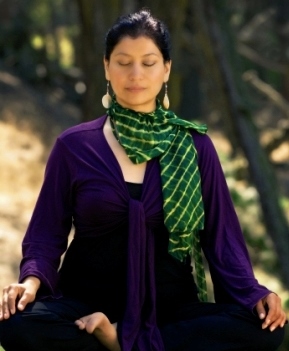
Prana means the breath, the air, life itself. Ayama means stretch, expansion, extension, length, prolongation, restrain or control. Pranayama, thus, means the conscious action of breathing with the purpose to expand and prolong the breath and its restraints.
At one point or another, we all have experienced deep breathing as a deep sigh of relief accompanied by a deep sense of weightlessness, or when we are excited, or stressed, and we take a few moments to take some centering breaths before we move on. Our breath is, undoubtedly, our most precious tool to calm and center the mind.
Only in recent decades and through experiment, Western medicine recognized the health-giving and invigorating effects of conscious respiration. Thousands of years ago, the yogis not only discovered that through the breath we could live and restore our bodies to wholeness by purifying and balancing the nervous system but also found that the breath plays an important factor in the control and calming of the mind. At the physical level, we bring new oxygen into our body, nourishing our blood, brain, bones and muscles. For our cells to keep functioning and producing energy, they need a constant refreshed supply of oxygen. Without oxygen, cellular function becomes impaired and cells begin to die. Through inhalations, we bring in new oxygen; through exhalations, our body expels Carbon Dioxide (the opposite effect is demonstrated by the process of photosynthesis in plants. For example, trees that “breathe in” carbon dioxide but “exhale” oxygen). Breathing, however, goes beyond the mere physical and physiological benefits in our bodies; it has the power to affect the psychological and cerebral activities as well as stimulating memory, creativity, and sense of expansion. Thus, it was viewed by ancient yogis as a way to attain the highest communion with the cosmic world and with the Self.
The Respiratory System
The respiratory system consists of a group of important anatomical features that include the nose, throat passages, lungs and diaphragm, which together enable the intake of oxygen on the inhale and the releasing of Carbon Dioxide on the exhale. This exchange of gasses takes place in the lungs, which are enclosed within the ribs, in the thoracic cavity. The lungs are two balloon-like organs. They are flexible and have the ability to expand and contract and are located inside the rib cage. As you inhale, into the chest, the lungs (and ribs) can expand towards the front, back, and to the sides. As you exhale, the chest and ribs lower, recoiling into the center of your chest. One inhale followed by an exhale form one cycle of breath. You can also direct the inhale into the belly. When you breathe into the belly, the top of the diaphragm pulls down into the abdominal cavity, lungs expand down, pushing the belly outward and allowing the lungs to inflate. Please see below for more info on Belly Breathing.
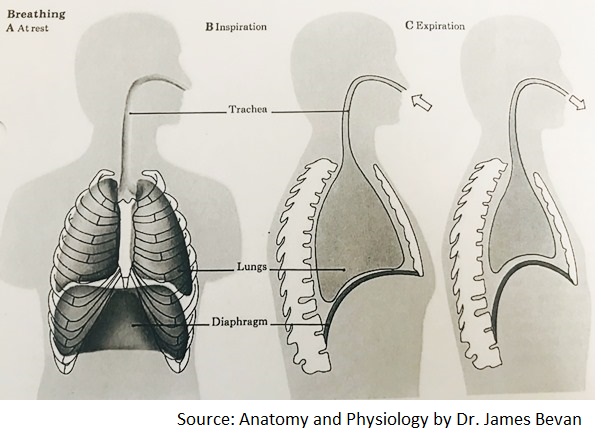
In his book, Light on Pranayama, B.K.S. Iyengar stated that during normal inhalation, an average person takes in about 500 cubic centimeters of air. During deep deep inhalation, the intake of air is about six times as great, amounting to almost 3000 cubic centimeters. The capacity of each person varies according to his/her constitution[1] The practice of Pranayama can increase the lungs capacity for expansion, breath intake, allowing for more oxygen to cleanse, ventilate and bring health to our bodies and to calm the mind.
Although you can also inhale through the mouth, inhaling through the nose has proven to be the most beneficial way to breathe. Inhaling through the mouth bypasses important stages in the breath process. At the physical level, nasal passages filter the air as it enters the lungs and protects us from bacteria entering the body. Nasal breathing warms the breath and keeps energies balanced. Breathing through the nose is especially beneficial during cold season or when the mouth and throat are dry or hoarse. Mouth breathing tend to create dryness and aggravate an already dry or sore throat.
The purpose of Pranayama is to make the respiratory system function at its best. When the breath is shallow and ragged, the physical, psychological and emotional bodies suffer. With shallow and unconscious breath, the body accumulates toxins and may create health challenges. “Respiratory control is accomplished by a complex, integrative control system with a difficult task to assure homeostasis of blood oxygen and carbon dioxide throughout life”, say G.S. Mitchel and T.L. Baker Herman[2]. It is no wonder that Pranayama is one of the eight limbs, or stages, of yoga through which the body develops understanding of the self.
The Power of the Diaphragm
The diaphragm is a dome shaped sheet of muscles located between the thoracic and abdominal cavities and helps the process of breathing. It is very flexible and has the ability to contract and expand. It contracts when oxygen is pulled into the lungs and expands when carbon dioxide is pushed out of the lungs. In other words, when the diaphragm contracts, it creates the space for the LUNGS to EXPAND; when the diaphragm relaxes (and expands), the LUNGS CONTRACT to expel the old breath (carbon dioxide). The lungs act in direct opposition. Inhaling is active and exhaling is mostly passive.
Through breath practices, we cultivate the flexibility of the muscles of the diaphragm and rib area, nurturing a home for our lungs to be able to expand in different directions.
Three types of breathing:
- Chest Respiration: Accessory muscles of the neck activate the top parts of the lungs.
- Intercostal or mid-breathing: The central parts of the lungs are activated. The ribs expand sideways on the inhalation; they contract, or recoil, on the exhalation. The movement of an accordion could mirror this action of intercostal breathing.
- Belly breathing: When you breathe into the belly, the top of the diaphragm pulls down into the abdominal cavity. The lower portions of the lungs are activated chiefly allowing a deep belly expansion, while the top and central portions remain less active. When you exhale, the diaphragm releases, lungs recoil, and you may use your abdominal muscles to deepen your exhalation.
However, when our diaphragm muscles become tight, contracted, or atrophied, the capacity of the lungs to expand and contract become limited and the intake of oxygen necessary to nourish every cell in the body is reduced; also, the build-up of carbon dioxide accumulates, which can cause toxicity in the body.
How the Breath is Reflected in the Emotional, Mental Body
Fight or Flight vs Relaxation Response
Our emotional body is also reflected in our breath. Modern life has placed an enormous amount of stress on society. Anxiety, insomnia, depression and other diseases are predominant and keep us in the fight or flight response. “Evolution has endowed all humans with a continuum of innate, hard-wired, automatically activated defense behaviors, termed the defense cascade. Arousal is the first step in activating the defense cascade; fight or flight is an active defense response for dealing with threat”[3]
When we are in the fight or flight response, our breath may become rapid, uneven, and shallow.[4] “Stilling of the body, measured by reductions in body sway and coupled with a drop in heart rate, has been interpreted as the human equivalent of freezing”. [5]
According to studies done by NCBI National Library of Medicine, the risk for serious mental illness is generally higher in cities, compared to rural areas. Epidemiological studies have associated growing up and living in cities with a considerably higher risk for schizophrenia. “Living in poverty can both contribute to and result from impairments associated with poor mental health. Social isolation and discrimination as well as poverty in the neighborhood contribute to the mental health burden”.[6]
The Impact of Urbanization
Urbanization is one of the main health-relevant changes humanity is facing today and will be facing in the future.
Some facts:
- Today, more than 50 percent of the global population is living in cities; by 2050, this rate will increase to nearly 70 percent with more than 50 percent of the urban population living in cities of over 500 000 inhabitants.
- With growing urbanization, more and more people are exposed to risk factors originating from the urban social (poverty), which in many cases leads to migration, or physical environment (traffic noise), contributing to increased stress, which in turn is negatively associated with mental health.[7]
When we induce the Parasympathetic System (the system in charge of “rest and digest” also known as the Relaxation Response), we begin to release tension, our breath is paced, easy, expansive, nurturing and nourishing. The Parasympathetic Nervous System is opposite in its functions to the Sympathetic Nervous System, or “Fight-or-Flight” response. It can be referred to as the part of the nervous system responsible for the internal functions when you are sitting, resting, and relaxing. Therefore, it would constrict the pupil, slow your heart rate, contract bronchial musculature, stimulate bronchial secretions, and enhance gut motility for digestion to effectively occur.[8]
Conscious breathing, therefore, is at the core of any yoga practice as it allows us to access the subtle body, stay focused, cultivate presence, center the mind, and nourish our physical bodies.
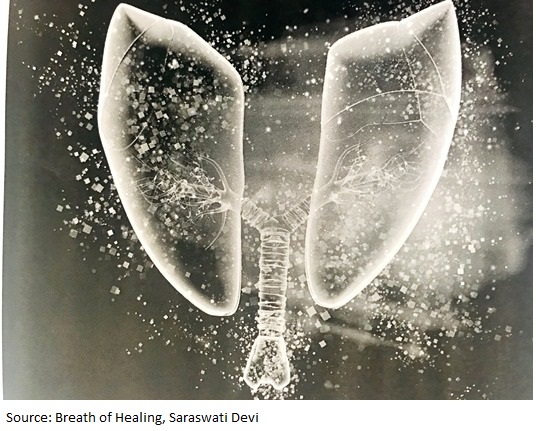
Summary:
- Our breath is undoubtedly, our most precious tool to calm and center the mind.
- Our breath has the power to affect the psychological and cerebral activities as well as stimulating memory, creativity, and sense of expansion
- Pranayama can increase the lungs capacity for expansion, breath intake, allowing for more oxygen to cleanse, ventilate and bring health to our bodies and to calm the mind.
- When we induce the Parasympathetic System we are relaxed, our breath is paced, easy, expansive, nurturing and nourishing.
- The Sympathetic Nervous System constricts the pupil, slows your heart rate, contracts bronchial musculature, stimulates bronchial secretions, and enhances gut motility for digestion to effectively occur.[8]
- Conscious breathing allows us to access the subtle body, stay focused, cultivate presence, center the mind, and nourish our physical bodies.
- Breath practices can stimulate, calm, or balance our nervous system.
- As a result of conscious breathing, we can sleep better, digest our food better, heal depression issues, headaches, migraines, stomach cramps, have more energy during the day, reduce physical and mental stress, and live with more awareness.
Experienced yoga teachers, breath or holistic therapists, may use different techniques to cultivate any of these aspects of the physiological body.
BREATH PRACTICES:
The following breath practices are simple techniques and are suitable for everybody to try at home, at the office, or in class (Pregnant women should consult their yoga teacher and doctor before practicing certain breath techniques). However, if you do not feel comfortable, or start experiencing some form of anxiety as you practice this breathing, please stop and consult your doctor.
Things to remember:
- The breath is never forced
- Always listen to your body
- Find a comfortable space where you can either lay down comfortably on your back, with appropriate support, or sit up straight.
- Chest and belly should be open and relaxed, never restricted.
1- Acknowledging your body and breath
Practice:
You may practice these breathing exercises in a comfortable seated position. However, if you are new to breath practices and/or need more comfort and ease, start lying down on your back (supine) in constructive rest. You can bend your knees (soles of feet on the floor), or place them over folded blankets or a bolster. This will release your lower back, will keep your spine straight and your belly relaxed. You may place a folded blanket under your head if your neck goes into too much extension (chin over lifting). Your neck and spine should be straight, chest open, tailbone and mid back released. Draw shoulder blades down your back so your shrugging muscles are kept away from the ears and your arms can release and elongate; palms face up.

- Consciously breathe in and let your body soften.
- Give yourself permission to be completely comfortable and at ease.
- Begin to cultivate connection with the earth, allowing the earth to hold you fully.
- Notice what it is like to be home, in your own body, with your own sensations. Begin to deepen the connection with your body and your breathing.
- Become aware of how the breath is doing. Is it full or shallow? Is it slow or rushed? Is it stuck in the throat or chest? This is only for you to notice your own breathing pattern.
- Consciously, breathe in through your nostrils and open your mouth as you exhale. Let go of something. Allow your body to soften. Take a few long inhales, long exhales, until you are completely at ease and comfortable in your own space, with your own breath.
- Begin to breathe in through your nostrils, exhale through your nostrils.
- Gradually, bring the breath to your belly (or notice where the breath goes and where it is most accessible), and deepen your breath. Breathe in one or two seconds longer, cultivating a sense of EXPANSION as you inhale, and full relaxation and grounding as you exhale. On the inhale, you expand, on the exhale your body releases and there is a sense of gentle contraction of the belly.
- Take a few more cycles of breath cultivating a feeling of expansion and grounding. If it feels comforting and relaxing, stay here for some time.
If you are new to breath practices, you may want to practice the above until you feel very comfortable with what you are doing, before moving on to the following practices.
MOVING ON:
2. Exploring the Breath in Different Parts of Your Torso and Expanding the Different Muscles
Chest 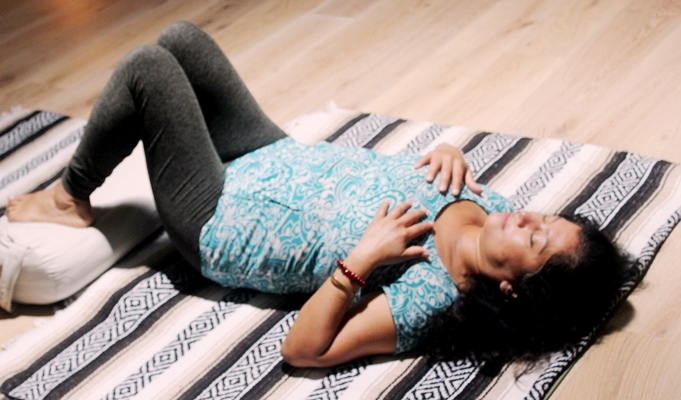 Breathing
Breathing
Practice:
- Bend your knees or keep them resting over a bolster or rolled up blankets.
- Bring your hands to your chest, underneath the collar bones and breathe into your hands.
- Feel your chest gently expanding as you inhale and contracting as you exhale. Do not push the breath. As with any breathing practice, try to focus on relaxing the rest of your body.
- Breathe into the chest gently, massaging your chest with the breath. Put only as much effort as you need to. Breathe this way for a few cycles, cultivating a feeling of gentle expansion as you inhale and a feeling of releasing as you exhale.
Benefits and risks of chest breathing:
- It can be stimulating. If you begin to feel anxious or overstimulated, stop practicing this technique
- It can help you free the joints of the ribs, the upper back and neck
- It can energize the body. You may practice this breath when you feel tired or lethargic
Intercostal Breathing
Intercostal muscles help us in the process of breathing and are, therefore, very important. “The intercostal muscles are a group of 22 pairs of tiny muscles found between the ribs. These muscles play a vital role in the movement of the chest during breathing. They also help to solidify the thoracic region and protect the lungs.” www.innerbody.com/image_chest1/
We use the intercostal muscles every day by simply breathing, but when those muscles lack strength and flexibility, our breath can become shallow. As you learn to expand and contract those muscles, you will also improve your respiratory health which will help improve your physical endurance.
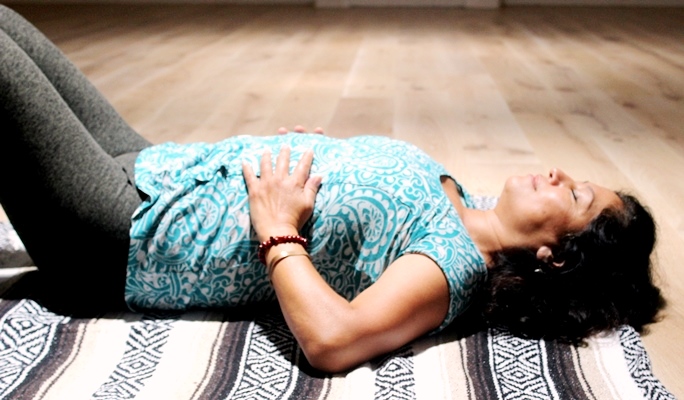
Practice:
- Bring your hands to your side, touching your rib cages.
- Bring your full awareness to either side of your ribs and breathe into your hands. Feel the expansion of the ribs. Allow them to expand sideways, like an accordion bellows.
- Breathe in gently, noticing the rhythm of the breath and the expansion of the ribs on inhale and gentle contraction on exhales. Breathe this way for a few minutes, noticing the rhythm of your rib cage.
- You can visualize massaging with your own breathing all vital organs that the ribs enclose, including your heart and lungs.
Belly Breathing
Practice:
- Move your hands to your belly, around your navel, and rest them gently.
- Breathe into your belly. Notice if it feels tight. Do not push the breath. Allow your belly to gently expand on the inhale and gently release on the exhale, massaging your belly with the breath.
- Gradually you may expand the inhales and elongate your exhales.
- Breathe into your belly for as long as you need to, or until your belly becomes heavy and soft, like water.
- Your breath should then become fluid; nice and easy belly breathing.
After a few minutes, let your arms rest by your body (or keep them on your belly if it feels comforting)
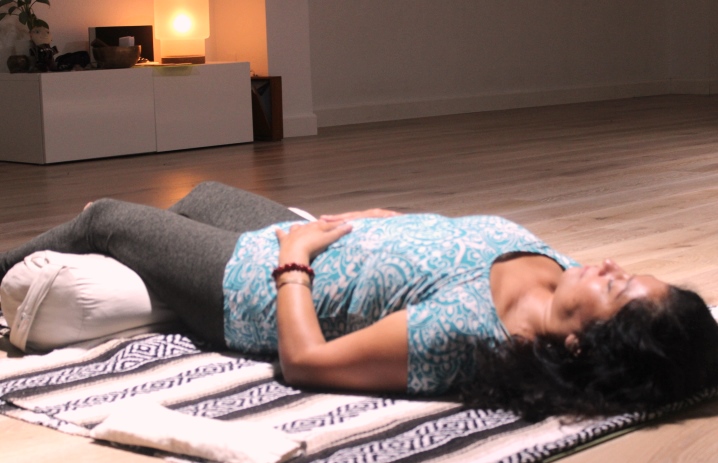
Belly breathing is very soothing and relaxing. Learning to breathe into the belly may not be so easy for some people. The belly may feel tight, or achy. Be gentle with yourself. Send your breath to your belly as a massage you are giving to your digestive system. Visualizing the movement of water can help the belly unwind and relax until the breath becomes fluid and the belly completely at ease. You may practice belly breathing anytime, especially when you are anxious or worried. Some people claim to have healed insomnia issues after practicing belly breathing, especially before bed.
Benefits of belly breathing:
- It soothes and relaxes mind and body
- It helps you cultivate a deep connection with the earth
- It strengthens pelvic floor muscles
- It teaches you to use your belly to protect your mid-back as you move through life
- It can help you cultivate a better posture
- It can help you move into Asanas (yoga physical postures) with more ease and strength
MOVING ON
3. Three-Part Breath: Exploring Breath Expansion
Three-part breath can be practiced once you are quite comfortable breathing into the chest, ribs, and belly. The three-part breath can help you regulate, expand, and balance the breath and ground your body.
Practice:
- Your arms can rest by the side body. Knees bent or over a bolster. Palms facing up.
- Breathe in through your nostrils and out through your mouth, until you can breathe in and out through your nostrils.
- As you inhale, breathe into the chest first, the side ribs next, and the belly last. The breath should feel like a wave of oxygen moving into your body expanding chest, lungs and belly.
- As you begin to exhale, the belly begins to release first, the ribs and chest last. The breath reverses its motion calmly until the old breath comes out of your body through your nostrils.
- Repeat breathing into the chest first, side ribs second, belly last. Notice the expansion, then exhale calmly, gradually releasing belly, side ribs, and chest. Notice the beginning, middle, and end of your breath and the body parts you expand as you inhale and exhale. Enjoy every second of your inhales and exhales.
- Practice this three-part breath technique for a few more cycles, exploring the movement of your torso: chest, side ribs, belly. Maybe you can begin to feel the muscle of the back body as well.
- Keep your face and rest of your body relaxed at all times.
4. Equal Inhales- Equal Exhales (Sama Vritti Pranayama)
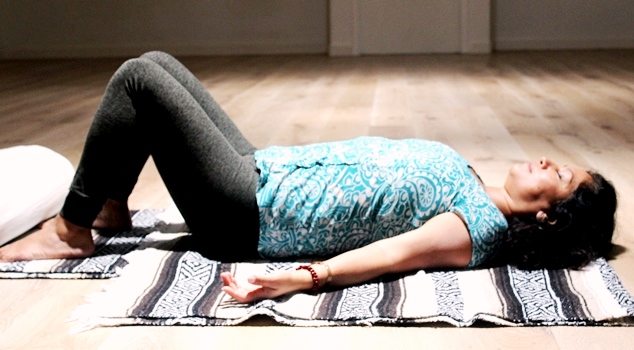
Sama: equal inhales, equal exhales. Vritti: Fluctuations. Pranayama: Breath expansion.
Equal inhales and exhales with the purpose to regulate, balance the breath and quiet the mind.
Sama Vritti Pranayama can be practiced almost anywhere. It can help reduce stress and anxiety. Through constant practice, you can strengthen your lung’s breath capacity and improve the way you feel, therefore improving the quality of your life.
Practice:
- Find a place to sit or lay in supine pose, knees bent or bolster underneath your knees. Make sure you are comfortable and ready to receive the breath and its benefits. You may close your eyes and relax your face.
- Breathe in fully and then release fully through your mouth, letting go of everything that will not serve this practice.
- Once you are ready, breathe in and out through your nostrils.
- If you are familiar with Ujjai breath technique (Victorious breath), please establish it (with the mouth closed, you make the sound of the wind on the back of your throat as you inhale and exhale). Otherwise, keep the breath soft and steady.
- You may start choosing a ratio of FOUR. Count of four on the inhale; four on the exhale. The focus is on developing all part of the breath along with a balanced direction of movement.
- Inhale, count up to four, no rushing (if it feels too short, start with a six count ratio. If it feels too long, start with what is available).
- Exhale, count up to four, no rushing (or six if you are using a ratio of six).
- Check in to see that your inhales and exhales have the same duration.
Try the above practice for three cycles of breath until you are comfortable; then continue:
- Inhale again. Same count. Notice beginning, middle and end of your inhalation.
- At the very TOP of your INHALE, PAUSE to notice the space of nothingness.
- Exhale. Notice beginning, middle, and end of your exhalation.
- At the very END of your EXHALE, PAUSE to notice the space. This is a way to help you keep your inhales and exhales regulated and on track, not jumbled together. If you practice yoga, it prepares you to use your breathe more effectively as you practice the Asanas. It also prepares you to explore longer inhales, longer exhales, and longer retention and pauses in between.
Practicing and noticing what works for you (or doesn’t) is key to understanding what you need and how you can begin to take control of your own well-being.
All sentient beings breathe: humans, animals, plants. When you see them, know they are doing the same thing you are doing: breathing, living, and following, just like you, the cycle of their own precious life.
Model photos by Nancy Wilson: www.nancywilsondesign.com

To read more about the benefit of conscious breathing, the diaphragm, the Parasympathetic Nervous System, and how breath practices are helping people heal, please go to:
https://www.inpursuitofyoga.com/blog/2015/3/11/chest-breath-vs-belly-breath
https://www.unm.edu/~lkravitz/Article%20folder/Breathing.html
https://www.sciencedirect.com/topics/neuroscience/parasympathetic-nervous-system
http://www.breath-body-mind.com/
Footnotes:
[1] Light on Pranayama, B.K.S, Iyengar, The Crossroad Publishing Co, 2001, pg. 15
[2] Encyclopedia of Neuroscience, 2009
[3] NCBI US National Library of Medicine Harv Rev Schyatri, 2015
[4] Overcoming Trauma Through Yoga, D. Emerson, E. Hopper, PhD. North Atlantic Book, 2011, pg 108
[5] NCBI US National Library of Medicine Harv Rev Schyatri, 2015
[6] PMC US National Library of Medicine National Institute of Health Dtsch Arztbl Int. 2017
[7] PMC US National Library of Medicine National Institute of Health Dtsch Arztbl Int. 2017
[8] Science Direct: Encyclopedia of Neuroscience, 2019


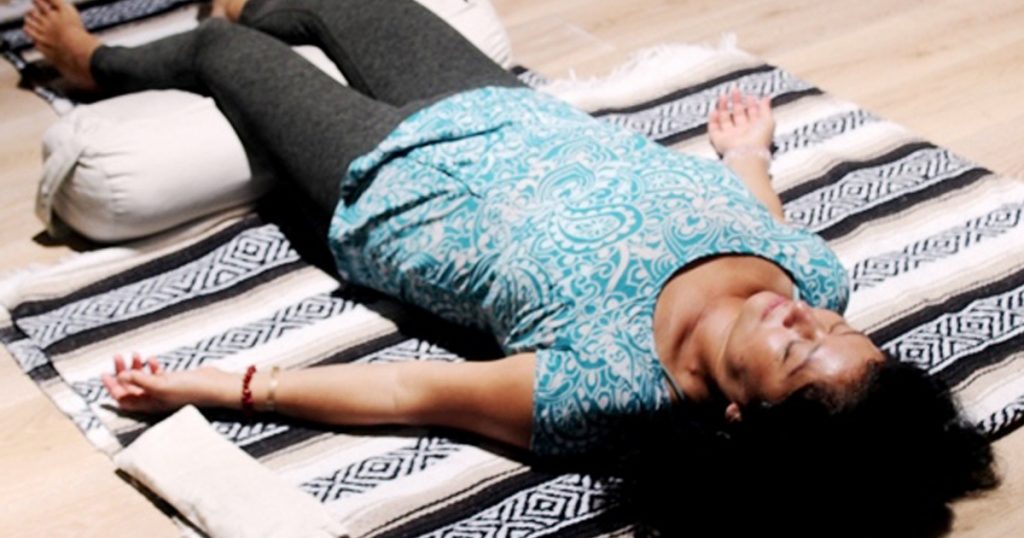
Awesome post! Keep up the great work! 🙂